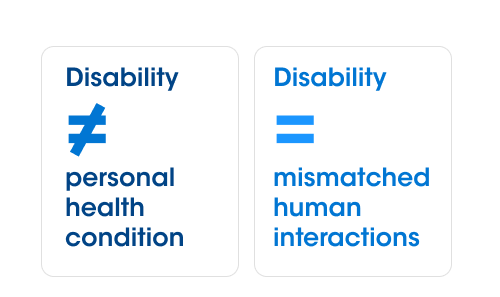Redefine Inclusive Designers
Learning Objectives
After completing this unit, you’ll be able to:
- Describe the qualities of successful inclusive designers.
- Discuss ability bias.
- Describe the social definition of disability.
Decide Who Designs
We’ve learned that the five elements of the cycle of exclusion can help us better recognize the habits that perpetuate mismatches. Asking who makes and how we make a solution are key components. To that end, we have to expand our definition of who’s a designer. Remember exclusion experts? (People who have experienced a high degree of exclusion are experts at recognizing exclusion.) Shifting to inclusive design practices means that we seek out exclusion experts early on and invite them to participate in the design process.
Exclusion experts may not have had formal training in a design-related field. But if they’ve solved for mismatches, then they are, in a way, designers. It’s likely these exclusion experts also have used their experience to modify solutions or products to address their specific needs. Just as great ideas can come from unexpected sources, a designer can be someone who understands a problem deeply and has insights about how to resolve design issues.
As technologies become ever more sophisticated and connected to so many intimate details of our lives, design teams need a variety of perspectives and expertise to inform the design process.
Skills for Success
Whether you come from a traditional design background or not, it’s helpful to keep in mind several skills a successful inclusive designer actively practices.
- Identify ability biases and mismatched interactions between people and the world.
- Create a broad collection of ways to participate in an experience.
- Design for interdependence and bring complementary skills together.
What do these skills mean? Let’s talk through them.
Ability Bias
Our capabilities and limitations affect how we interact with a solution or product. When we’re designing, if we start by considering ability, we can more easily get everyone on the same page. The challenge is that, out of all the biases that designers bring to the table, ability biases are the sneakiest.
An ability bias is the habit of using our own abilities as the baseline to solve problems. If we don’t recognize our ability biases, then the products we design will work well only for people who have similar abilities to our own. Ability biases may be related to physical, cognitive, or societal aspects. Even the design tools we use reflect our ability biases.
Once we get into the habit of recognizing our own ability biases, we can begin to address them. We do have to be careful not to develop a false sense of empathy. Wearing a blindfold for a few hours won’t suddenly make you understand what it’s like to be blind.
Disability Is About Mismatches
The World Health Organization describes disability as “a complex phenomenon, reflecting the interaction between features of a person’s body and features of the society in which they live.” This is the social definition of disability, and it recognizes that disability is a mismatch between a person’s abilities and the environment or points of interaction. It’s very different from the medical model of disability, which describes disability as the result of a physiological or cognitive difference.

The social definition of disability recognizes that disability is a mismatch between a person’s abilities and the environment or points of interaction.
Approaching disability as a mismatched interaction opens up possibilities. It also emphasizes the responsibility of the designer, because every design choice either increases or decreases mismatches between people and the world around them.
A Variety of Ways to Participate
We said earlier that inclusion is important because a particular design could potentially prohibit someone from participating in an experience or using a product. An example of this comes from the world of gaming. Most game controllers require two hands to operate. What if you don’t have the use of your hands? How would you play video games? There are now adaptive controllers that can be used in different ways. But for many decades, there was just one type of controller and thus one way to participate.
Creating a variety of ways for people to participate in an experience leads to accessibility and means that more people will be able to participate. It’s also important for designers to think about interdependence, which is about creating interactions that allow people to contribute their skills in complementary ways and also collectively. As they say, the more the merrier!
Resources
- Salesforce Site: Designing for Difference: Why I’m Calling for a New Approach to Product Design
- External Site: Why Design Should Include Everyone